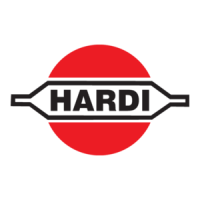5 - Operation
64
Rinsing when main tank is not empty
Rinsing the pump, operating units, spray lines, etc. in case of stop in spraying (e.g. because of rain), before main tank is empty.
Cleaning of the liquid system:
1. Turn suction valve towards . (Keep pressure valve in -position). Close Self-Cleaning filter, if possible.
2. Close AgitationValve (no agitation).
3. Engage the pump. Set the pump speed to approximately 300 rpm and increase the spraying pressure to 6 bar. Spray
the water from the rinsing tank into the field, until all nozzle tubes and nozzles have been flushed with clean water.
4. Disengage the pump.
μ
ATTENTION! It is advisable to increase the forward speed (double, if possible) and reduce the spraying pressure to 1.5
bar, when spraying diluted remaining liquid in the field just sprayed.
Cleaning the sprayer on the outside
±
WARNING! External cleaning with a spray gun is only possible with emptied and cleaned main tank. Do a complete
main tank cleaning, before attempting to use the spray gun!
1. Turn suction valve towards and pressure valve towards . Keep other valves closed.
2. When another 1/3 of the contents in the rinsing tank(s) is used, turn the suction valve towards . Adjust the spraying
pressure to 8 - 10 bar.
3. Open the manual valve at the operating unit and wash the sprayer with the cleaning device located on sprayer’s rear
side. If neccessary, the pressure can be adjusted on the pressure regulation valve.
4. Disengage pump again.
μ
ATTENTION! If the sprayer is cleaned with a high pressure washer, lubrication of the entire machine is recommended.
Use of Detergents
It is recommended to use an appropriate cleaning detergent suitable for cleaning agricultural sprayers.
• Cleaning detergents containing a suitable lube or conditioner are recommended.
• If for some reasons this is not available, and e.g. triple ammonia water is used, it is important to rinse the spray circuit
immediately after and add some lubricant to the rinsing water to prevent ball valves etc. seizing up.
• Use of automotive antifreeze/radiator coolant (ethylene glycol) will protect valves and seals from drying or seizing up.
Technical Residue
An amount of spray liquid will inevitably remain in the system. It cannot be sprayed properly on the crop, as the pump takes
in air, when the tank is just about empty.
This technical residue is defined as the remaining amount of liquid in the system, when the first clear pressure drop appears
on the pressure gauge.
The residual dilutable volume is approx. 16 litres. See the section “Technical Specifications” for more details.
The residues in the tank should be diluted immediately in a ratio of 1:10 with clean water. Afterwards it should be sprayed
on the crop just sprayed with increased driving speed. In addition, also pump, linkage and armature can be separately rinsed
with water from the rinsing tank. However, it must be ensured that the liquid in the spray lines are in unchanged
concentration. Therefore there should be an untreated field area available to spray this liquid out.

